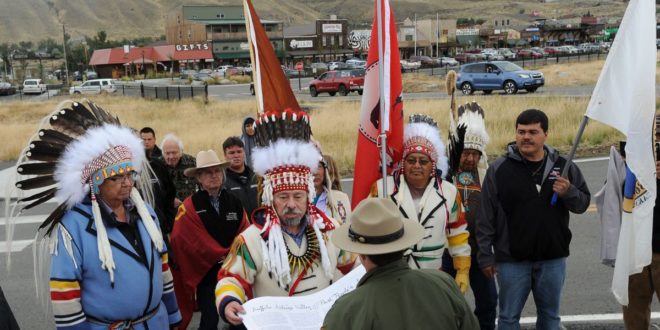Saturday, representatives from over half-a-dozen Native American tribes gathered outside Gardiner, Montana to protest a pair of Yellowstone place names.
Earlier this week, we reported members of the Blackfoot Confederacy and the Great Sioux Nation would gather near the Roosevelt Arch and present a formal petition to the National Park Service to change the names of Mount Doane and Hayden Valley—names that tribes say valorize and normalize genocide.
According to the Billings Gazette, several chiefs and chairmen (including Stan Grier, Chief of the Piikani Nation of Alberta, Canada and Brandon Sazue, Chairman of the Crow Creek Sioux Tribe of South Dakota) delivered speeches condemning Gustavus Cheyney Doane and Ferdinand Vandeveer Hayden, describing their status as Yellowstone place names as a “desecration.”
After the speeches, Blackfoot and Sioux tribal reps signed a petition and formally presented it to Yellowstone Deputy Superintendent Pat Kenney, one of three Yellowstone officials in attendance.
In his speech, Grier called attention to several place names still in use in the Greater Yellowstone Area that have roots with Native American tribes. From the Gazette:
“So well did we know this area, that some of the names our people use for features of this land are still used today, like the Beartooth Mountains, the Heart Mountain near Cody, and today we are here because of very different names,” Grier told about 50 people gathered in the Gardiner Community Center on Saturday afternoon.
The tribes are seeking Mount Doane be renamed First People’s Mountain and Hayden Valley be renamed Buffalo Nations Valley.
Both Doane and Hayden feature prominently in the creation of Yellowstone National Park. Doane, as a U.S. Army Lieutenant, led an escort for the 1870 Washburn Expedition, whose findings were later promoted in Scribner’s Monthly in 1871. The same year, Hayden led a Geological Survey into the park, which Doane also accompanied. Indeed, Hayden named Mount Doane for his participation.
Although important to the park’s formation, both men’s names carry a far different connotation outside explorations and surveys.
Although associated with Yellowstone, Doane is far more infamous as a player in the Indian Wars—most prominently for his role in the heinous 1870 Marias Massacre, when over 200 Piegan Blackfeet (many of whom were children or elders) were slaughtered in their camp. For his actions alone, as “first and last man” in the attack, as well as his subsequent pride in the events described, Montana historians Kim Allen Scott and Paul Wylie say his name has no place in Yellowstone.
Hayden, meanwhile, did not participate in events like the 1870 Maris Massacre. However, he did espouse derogatory views toward Native American culture and touted the widely held belief that unless tribes took up agriculture and abandoned their traditional practices, they would face “extinction.”
Scott, as well as Montana Historical Society reference historian Zoe Ann Stultz, argue Hayden’s rhetoric, however loathsome, doesn’t enter the same realm as Doane’s actions. The Gazette reports Chief Grier, during his speech, disagreed with such assertions, arguing, “words are what incite genocide” and pointed to the Rwandan genocide in 1994 as an example of this.
What’s In A Name?
The Rocky Mountain Tribal Leaders Council previously voted in 2014 against the chosen names for Mount Doane and Hayden Valley. Tribal reps say they asked the park last year to rename both features; Yellowstone Superintendent Dan Wenk responded saying it wasn’t his—or the National Park Service’s—decision.
Although the National Park Service oversees parks like Yellowstone, they are not responsible for its names. That responsibility lies with the U.S. Board of Geographic Names, a body of 22 government agency representatives. From the Gazette:
According to Jennifer Runyon, the board’s senior researcher, the process goes like this: The board receives an official application for a name change, including a summary of the reasoning behind the request. Board staff then solicit input from county, state and, in this case, Park Service officials and prepare a case brief based on the information they’ve gathered.
Once everyone has weighed in and the materials are prepared, the item is added to the agenda for the board, which meets once every three months, to discuss the pros and cons.
“Even if we got a proposal today, we’re talking six to eight months,” Runyon told the Gazette.
The federal board has been aware of the tribes’ condemnation of the two geographic labels for a couple years, she said, but the process can’t begin until a proposal is formally submitted.
“That never happened, so there’s essentially the perception out there that the board hasn’t been doing anything, and we can’t until they propose it,” she said Thursday.
If an official request is made, Wenk, along with Park County, the Wyoming board of geographic names and tribes affiliated with the Yellowstone region will each submit a recommendation.
Yellowstone National Park has not taken an official stance. In light of last year’s request, Wenk told the Gazette last week that, “the National Park Service understands that this is an important and sensitive issue.” And Deputy Superintendent Kenney, speaking to Grier yesterday, said “We came today to listen, learn and hear your perspective.”
Grier told Saturday’s crowd that, although Yellowstone is “the world’s first national park,” it’s also ancestral land for him and many area tribes.
 Yellowstone Insider Your Complete Guide to America's First National Park
Yellowstone Insider Your Complete Guide to America's First National Park





